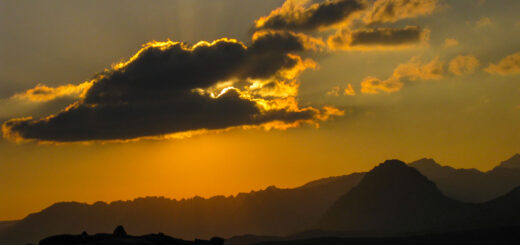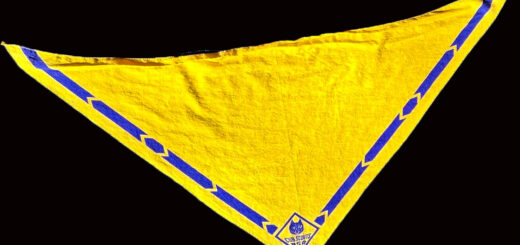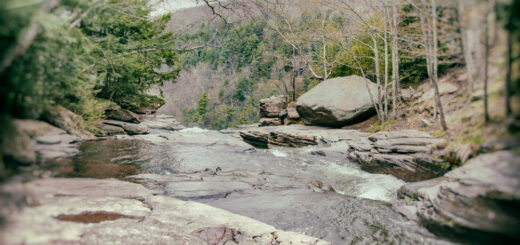Looking for Four-Thirty-Three
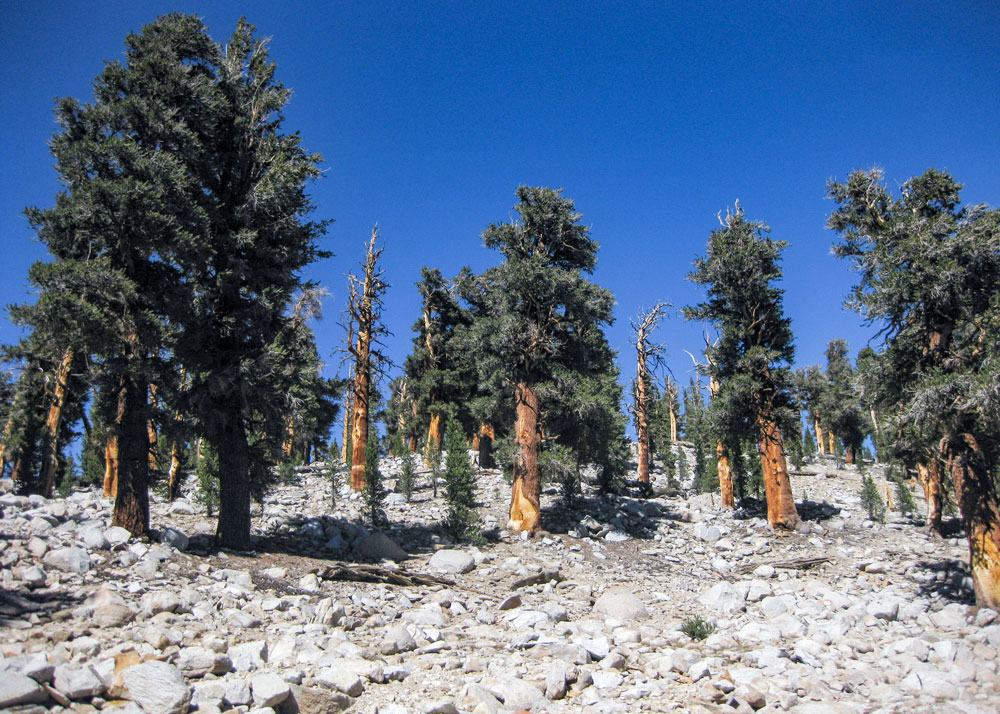 We had been traveling through the high country for days. Mountains and canyons and too much sun. Along the way we skirted a lonesome, treeless tarn. Beyond that rose a steep gravelly slope crowned with an ancient grove of foxtail pines. Bill had his sights set on those trees. Years ago he conducted a passing investigation of this place and something about it captured his imagination. He made a note on his map and resolved one day to return and camp there. He told his friends about this place, “the best campsite anyone could imagine.” We heard him tell the story many times. We got caught up in it too.
We had been traveling through the high country for days. Mountains and canyons and too much sun. Along the way we skirted a lonesome, treeless tarn. Beyond that rose a steep gravelly slope crowned with an ancient grove of foxtail pines. Bill had his sights set on those trees. Years ago he conducted a passing investigation of this place and something about it captured his imagination. He made a note on his map and resolved one day to return and camp there. He told his friends about this place, “the best campsite anyone could imagine.” We heard him tell the story many times. We got caught up in it too.
* * *
In California’s Sierra Nevada, foxtail pines occur only at the highest elevations in the southern end of the range, between nine and twelve thousand feet. Higher than that, it’s just the stark rock of the loftiest peaks. Foxtail pines grow in pure stands, or in some places mixed with lodgepole pine. The open structure of these forests and the bare soils they are rooted in inhibit the spread of fire, so these groves don’t burn. Foxtail pine is one of the longest lived of any tree. The principal causes of death among individual trees are lightning, avalanche, and rockfall. Beyond the pale of any given grove of foxtail pines, one observes the severe forms of dead and down trees, as well as bleached slivers of wood lying in swaths upon bare mineral soil. Dead foxtail pines are slow to decay. Studies indicate that wood shards lying on the ground at these desolate locations can be more than four thousand years old. Scientists refer to such relics as “ghost forests.”
* * *
We followed Bill in a slow trod up the steep slope toward the foxtail pines. When we reached the lower edge of the grove, we thought we had arrived, so we dropped our packs. This looked to be as good a campsite as any. But Bill kept going, alone, climbing higher and higher. He was looking for something and wasn’t going to stop till he found it. From where we were watching downslope, his image grew more and more distant, until it became a weather-blasted foxtail pine that walked like a man and vanished.
* * *
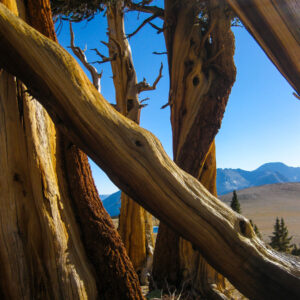 Horticulturists have never been keen on foxtail pine. Few even know of its existence. The growing conditions occurring in botanical gardens and suburban yards are insufficiently severe for trees like these to thrive. One horticulturalist who did appreciate the foxtail was Nellie Lester Rowntree. She was born in 1879 and lived to be more than one hundred years old. Beginning in the 1930s—she was already in her fifties—Rowntree wandered the California backcountry all by herself, collecting the seeds of wild plants. She brought them back and cultivated them in her nursery at Carmel-by-the-Sea and helped to popularize the use of native plants among gardeners in California. She continued her solo backcountry wandering and seed-collecting well into her eighties and published two fine books on wildflowers and shrubs. A manuscript she wrote on landscaping with California native trees—including the foxtail pine—was lost in a house fire, along with all of her field notes. The wisdom gleaned from her intimacy with trees went with her to the grave in 1979. First editions of her books are now highly collectible.
Horticulturists have never been keen on foxtail pine. Few even know of its existence. The growing conditions occurring in botanical gardens and suburban yards are insufficiently severe for trees like these to thrive. One horticulturalist who did appreciate the foxtail was Nellie Lester Rowntree. She was born in 1879 and lived to be more than one hundred years old. Beginning in the 1930s—she was already in her fifties—Rowntree wandered the California backcountry all by herself, collecting the seeds of wild plants. She brought them back and cultivated them in her nursery at Carmel-by-the-Sea and helped to popularize the use of native plants among gardeners in California. She continued her solo backcountry wandering and seed-collecting well into her eighties and published two fine books on wildflowers and shrubs. A manuscript she wrote on landscaping with California native trees—including the foxtail pine—was lost in a house fire, along with all of her field notes. The wisdom gleaned from her intimacy with trees went with her to the grave in 1979. First editions of her books are now highly collectible.
* * *
Time passed. Bill had not returned from the upper reaches of the foxtail grove. Someone asked: “Should we go tell him we found a perfectly good campsite right here?” Someone else said that wouldn’t be a good idea. Bill was seeking something and there was no stopping him. Best to remain where we were. So we did. That’s when we took notice of the small aluminum disks, about the size of a quarter and inscribed with a number, one nailed into the base of each of the large foxtail pines in the grove. There must have been hundreds of them. Bill had told us about these disks, the remnants of somebody’s field experiment from fifty years ago to determine the longevity of foxtail pines. The wild extremes of a half-century of alpine weather had popped many of the disks from the trees to which they had been affixed. Some lay scattered on the ground, along with the nails that once secured them. Others had been absorbed into the depths of living tree bark. A few remained in situ, blanched, their numbers barely legible.
* * *
Foxtail pines do not grow in Woodstock, New York. On the other hand, Woodstock is where the composer John Cage debuted a work officially titled 4’33”. It was performed on August 29, 1952, in the Maverick Music Hall. The piece is officially known by the title 4’33” but Cage himself always referred to it as the “silent piece.” And that’s what it is: four minutes and thirty-three seconds of silence. The pianist—David Tudor—just sat there at the piano, hands poised above the keys, as if about to play, but never commencing. Nothing happened. Silence was being presented as music. Well, not exactly silence. The gentle pattering of rain could be heard on the roof. Nobody knew what to make of it, this music-less music. Expecting something, the audience got nothing. They were just sitting there, listening to nervous coughs instead of harmonious notes. The sound of rain intensified. The audience grew more agitated. Many of them walked out. Some remained and became verbally abusive. In the end, somebody stood up on his chair and shouted: “Good people of Woodstock, let’s run these villains out of town!”
* * *
Bill finally abandoned his quest in the upper reaches of the foxtail grove and returned to where we were sitting. He arrived with a discouraged look on his face, dropped his pack, and sat down against the biggest foxtail pine in the grove. “I can’t find it,” he said. “I’ve looked everywhere in this grove. It must have fallen over.”
“Find what?” we asked.
“Foxtail 433. That’s what I wrote on my map. Here, look for yourselves.” We looked at his map. There were the words he wrote years ago: “Best campsite ever. Next to 433.”
“Hey, Bill,” someone said, pointing at the tree he was sitting against. “What number is that?”
Dangling from a loose nail near the base of the tree was a scuffed aluminum disk. Bill turned his head to look. He squinted to read the number. The smile that broke out on his face said, “433.”
After that we set up camp at the best site ever.
©John P. O’Grady
Appeared in The Mountain Eagle on February 12, 2021. (An earlier version was posted on my erstwhile Land in the Sky blog at The Mountain Gazette.)
